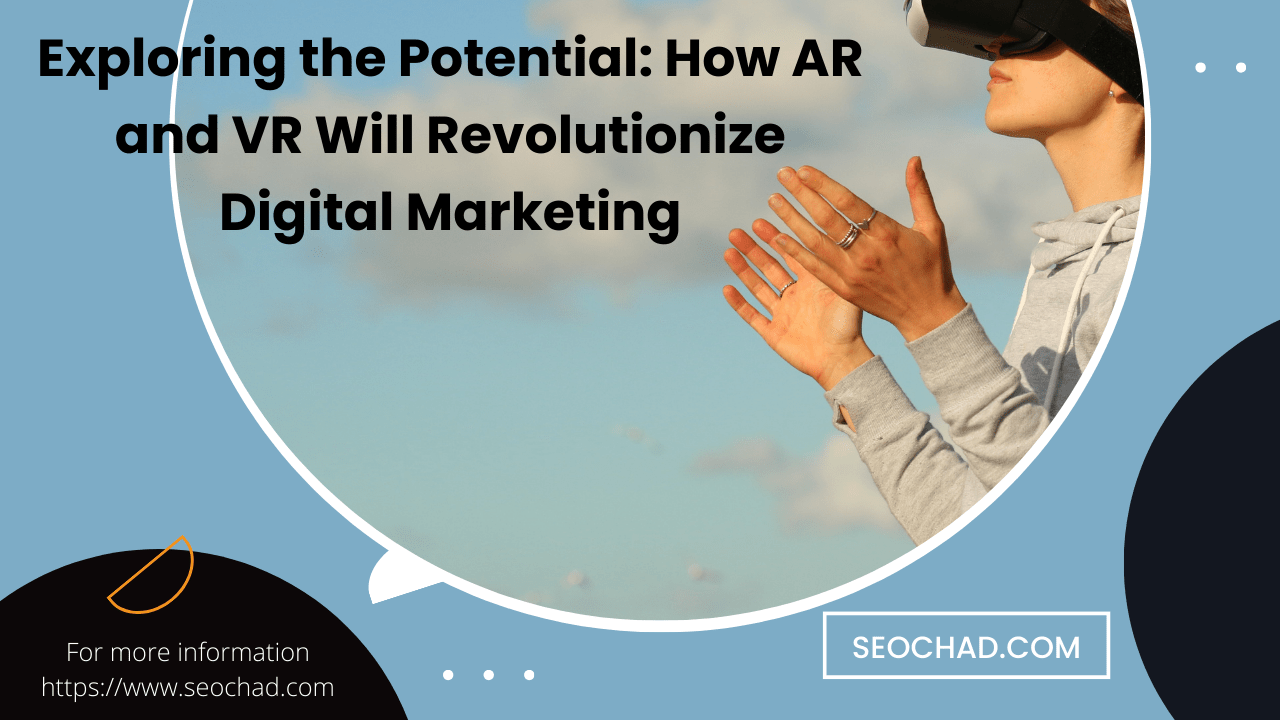Are you ready to step into a whole new dimension of digital marketing? Brace yourself, because the future is here and it’s bringing Augmented Reality (AR) and Virtual Reality (VR) along for the ride. These groundbreaking technologies have transcended their sci-fi origins to become powerful digital tools that are reshaping the way businesses connect with their customers. In this blog post, we’ll dive deep into the potential of AR and VR in revolutionizing digital marketing, uncovering how these immersive experiences can captivate audiences like never before. So strap on your virtual goggles and get ready to explore a world where imagination meets reality!
What is Augmented reality (AR) and virtual reality (VR)?
The world of marketing is always changing and evolving. With new technology comes new opportunities to reach and engage with consumers. Augmented reality (AR) and virtual reality (VR) are two emerging technologies that have the potential to revolutionize digital marketing.
AR is a technology that superimposes computer-generated images on top of real-world surroundings. This can be used to create interactive experiences for users. For example, a user could point their phone at a product in a store and see additional information about that product, such as reviews or pricing.
VR is a completely immersive experience where users are transported into a computer-generated world. This can be used to create lifelike simulations for training or marketing purposes. For example, a user could try on a virtual reality headset and be transported into a simulated store environment where they can interact with products before making a purchase decision.
Both AR and VR have the potential to change the way digital marketing is done. These technologies can be used to create more engaging and interactive experiences for consumers. As these technologies become more widespread, we will likely see more companies using them to market their products and services in innovative ways.
How can AR and VR be Used in Digital Marketing?
AR and VR are two of the most talked about technologies in the digital marketing world today. While both have been around for a while, their potential use in marketing is only now being realized. Here are some ways that AR and VR can be used in digital marketing:
- Create an immersive brand experience: Consumers today are bombarded with marketing messages from all directions. AR and VR can help brands cut through the noise by creating an immersive experience that allows consumers to engage with the brand on a personal level.
- Increase customer engagement: AR and VR can also be used to increase customer engagement. For example, retailers can use AR to provide customers with a virtual tour of their store before they even step foot inside. This can help create a more personal shopping experience and build loyalty among customers.
- Drive sales: Ultimately, the goal of any digital marketing campaign is to drive sales. AR and VR can be used to increase conversions by giving customers a realistic preview of products they are interested in purchasing. For example, furniture retailers could allow customers to virtually try out couches in their living room before buying them, or cosmetics companies could let customers test out makeup shades on their own faces.
- Enhance existing campaigns: AR and VR can also be used to enhance existing digital marketing campaigns. For instance, if a brand is launching a new product, it could create an augmented reality experience that allows consumers to see what the product looks like in real life before they buy it. This could create a more powerful marketing message and drive more sales.
Benefits of Using AR/VR in Digital Marketing
Digital marketing is constantly evolving and looking for new ways to engage consumers. Augmented reality (AR) and virtual reality (VR) are two cutting-edge technologies that are beginning to be used more frequently in digital marketing campaigns. This is because AR/VR has the potential to revolutionize the way consumers interact with brands.
Some of the benefits of using AR/VR in digital marketing include:
- Increased Engagement: AR/VR can provide a more immersive and interactive experience for users, which can help to increase engagement levels.
- Greater Connection with Customers: AR/VR can help create a deeper connection between customers and brands as it allows customers to experience products or services in a completely new way.
- Enhanced Customer Experience: By using AR/VR, marketers have the opportunity to greatly enhance the customer experience by making it more personal and memorable.
- Boosted Sales Figures: Ultimately, the goal of any digital marketing campaign is to boost sales figures and conversion rates. The use of AR/VR can help achieve this by providing an engaging and interactive experience that encourages users to make a purchase.
Examples of AR/VR Use Cases in Digital Marketing
There are a number of ways that augmented reality (AR) and virtual reality (VR) can be used in digital marketing. Here are a few examples:
- AR can be used to create interactive experiences for customers. For example, Ikea has an app that allows users to see how furniture would look in their homes before they purchase it.
- VR can be used to give customers a realistic experience of products or services before they commit to them. For example, travel companies can use VR to give potential customers a taste of what their holiday could be like.
- AR and VR can both be used for event marketing. For example, brands can use AR to create interactive experiences at trade shows or conferences, or they can use VR to transport potential customers to the event location so they can experience it before making the decision to attend.
- AR and VR can also be used for product promotion and demonstration. For example, car manufacturers could use VR to let potential customers test drive their vehicles from the comfort of their own homes, or beauty brands could use AR to let users try on makeup products before they buy them.
Challenges for Adopting AR/VR in Digital Marketing
The adoption of augmented reality (AR) and virtual reality (VR) technology in digital marketing is still in its early stages, with most companies only just beginning to experiment with these new platforms. However, there are already a number of challenges that need to be addressed before AR and VR can be fully integrated into digital marketing campaigns.
One of the main challenges is the high cost of AR and VR hardware, which can make it difficult for small businesses to justify the investment. Additionally, there is a lack of skilled workers who are able to develop and implement AR and VR solutions. This skills gap is likely to widen as demand for AR and VR grows.
Another challenge facing businesses wanting to adopt AR or VR is consumer awareness and understanding. Many people are still unfamiliar with how these technologies work, which can make it difficult to market products or services using AR or VR. Additionally, some consumers may be wary of using AR or VR due to privacy concerns around data collection.
Despite these challenges, there is huge potential for AR and VR in digital marketing. These technologies have the ability to create immersive experiences that can engage consumers on a deeper level than traditional marketing channels. With the right strategy in place, businesses can use AR and VR to stand out from the competition and deliver truly innovative campaigns that drive results.
Future Opportunities for AR/VR in Digital Marketing
Digital marketing is evolving rapidly, and new technologies are emerging all the time. One of the most promising new technologies is augmented reality (AR) and virtual reality (VR). These cutting-edge technologies have the potential to revolutionize digital marketing, and they offer a number of advantages over traditional marketing techniques.
AR and VR can provide a more immersive experience for consumers. They can also be used to create more personalized experiences, which can lead to higher levels of engagement and conversion rates. In addition, AR and VR can be used to target specific demographics and locations with highly relevant content.
Digital marketers should start exploring the potential of AR and VR now. These technologies are still in their early stages, but they hold a lot of promise for the future of digital marketing.
Conclusion
It is clear that AR and VR are the future of digital marketing. With the range of possibilities these two technologies provide, businesses have an unprecedented opportunity to engage consumers in a completely new way. This type of immersive experience has already begun to revolutionize many aspects of everyday life, and digital marketing is only set to benefit from it further as we continue to explore its potential.




